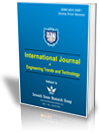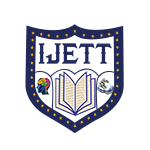NSGRF: Plant Leaf Disease Detection Using Multi Objective Genetic Algorithm Features Optimization with Random Forest
NSGRF: Plant Leaf Disease Detection Using Multi Objective Genetic Algorithm Features Optimization with Random Forest |
||
 |
 |
|
| © 2025 by IJETT Journal | ||
| Volume-73 Issue-3 |
||
| Year of Publication : 2025 | ||
| Author : Harminder Kaur, Neeraj Raheja |
||
| DOI : 10.14445/22315381/IJETT-V73I3P134 | ||
How to Cite?
Harminder Kaur, Neeraj Raheja, "NSGRF: Plant Leaf Disease Detection Using Multi Objective Genetic Algorithm Features Optimization with Random Forest," International Journal of Engineering Trends and Technology, vol. 73, no. 3, pp. 487-502, 2025. Crossref, https://doi.org/10.14445/22315381/IJETT-V73I3P134
Abstract
The agricultural sector in India, a developing nation, relies heavily on agriculture for its population’s livelihood and food security. Plants are essential for sustenance, medicine, and various industries. India’s agricultural sector contributes 17% to the GDP and ranks among the top three nations in producing staple crops like rice and wheat and cash crops like cotton and vegetables. This study is focused on the production and subsequent evaluation of an advanced plant disease classification system using the Plant Village dataset. The proposed approach integrates texture feature extraction, multi-objective optimization, and Random Forest Classifier to enhance classification accuracy and efficiency. Texture features are extracted from the Gray-Level Co-Occurrence Matrix (GLCM) and using Local Binary Patterns (LBP), providing a low-dimensional yet interpretable representation of leaf patterns. This feature extraction method reduces overfitting, especially in scenarios with limited sample sizes. The Random Forest parameters are optimized using multi-objective evolutionary algorithms like NSGA-II, ensuring a balance between model complexity and generalization capability. A genetic algorithm is employed for feature selection and weighting, which, combined with Random Forest techniques, further refines the classification performance. Extensive testing demonstrates the suggested method’s effectiveness, significantly outperforming previous methods. The NSGRF approach, a key element of the system, significantly outperforms in terms of precision, accuracy, recall, and F-score. The study’s findings indicate that this integrated approach is more accurate and offers faster inference times and improved interpretability; in this way, it can be a significant device for automatically detecting plant diseases in the agricultural technology field. In the experiment survey, the algorithm NSGRF improves 2% accuracy, 1 % precision, 2 % recall, and 1% f-score compared to other approaches.
Keywords
Plant disease, Feature extraction, Multi-objective optimization, Machine Learning, Genetic Algorithm.
References
[1] Imtiaz Ahmed, and Pramod Kumar Yadav, “Plant Disease Detection Using Machine Learning Approaches,” Expert Systems, vol. 40, no. 5, 2023.
[CrossRef] [Google Scholar] [Publisher Link]
[2] Divyanshu Varshney et al., “Plant Disease Detection Using Machine Learning Techniques,” 3rd International Conference for Emerging Technology, Belgaum, India, pp. 1-5, 2022.
[CrossRef] [Google Scholar] [Publisher Link]
[3] Mayuri Sharma, Chandan Jyoti Kumar, and Aniruddha Deka “Early Diagnosis of Rice Plant Disease Using Machine Learning Techniques,” Archives of Phytopathology and Plant Protection, vol. 55, no. 3, pp. 259-283, 2022.
[CrossRef] [Google Scholar] [Publisher Link]
[4] S.K. Mahmudul Hassan et al., “A Survey on Different Plant Diseases Detection Using Machine Learning Techniques,” Electronics, vol. 11, no. 17, pp. 1-23, 2022.
[CrossRef] [Google Scholar] [Publisher Link]
[5] Anwar Abdullah Alatawi et al., “Plant Disease Detection Using AI Based VGG-16 Model,” International Journal of Advanced Computer Science and Applications, vol. 13, no. 4, pp. 718-727, 2022.
[CrossRef] [Google Scholar] [Publisher Link]
[6] R. Sujatha et al., “Performance of Deep Learning Vs Machine Learning in Plant Leaf Disease Detection,” Microprocessors and Microsystems, vol. 80, 2021.
[CrossRef] [Google Scholar] [Publisher Link]
[7] Vibhor Kumar Vishnoi, Krishan Kumar, and Brajesh Kumar, “Plant Disease Detection Using Computational Intelligence and Image Processing,” Journal of Plant Diseases and Protection, vol. 128, no. 1, pp. 19-53, 2021.
[CrossRef] [Google Scholar] [Publisher Link]
[8] Saurav Roy et al., “Plant Disease Detection Using Machine Learning Tools with An Overview on Dimensionality Reduction,” Data Analytics in Bioinformatics: A Machine Learning Perspective, pp. 109-144, 2021.
[CrossRef] [Google Scholar] [Publisher Link]
[9] Majji V. Applalanaidu, and G. Kumaravelan, “A Review of Machine Learning Approaches in Plant Leaf Disease Detection and Classification,” 3rd International Conference on Intelligent Communication Technologies and Virtual Mobile Networks, Tirunelveli, India, pp. 716-724, 2021.
[CrossRef] [Google Scholar] [Publisher Link]
[10] Aditi Singh, and Harjeet Kaur, “Potato Plant Leaves Disease Detection and Classification Using Machine Learning Methodologies,” 1st International Conference on Computational Research and Data Analytics, Rajpura, India, vol. 1022, no. 1, pp. 1-10, 2021.
[CrossRef] [Google Scholar] [Publisher Link]
[11] Md. Asif Iqbal, and Kamrul Hasan Talukder, “Detection of Potato Disease Using Image Segmentation and Machine Learning,” International Conference on Wireless Communications Signal Processing and Networking, Chennai, India, pp. 43-47, 2020.
[CrossRef] [Google Scholar] [Publisher Link]
[12] Huiqun Hong, Jinfa Lin, and Fenghua Huang, “Tomato Disease Detection and Classification by Deep Learning,” International Conference on Big Data, Artificial Intelligence and Internet of Things Engineering, Fuzhou, China, pp. 25-29, 2020.
[CrossRef] [Google Scholar] [Publisher Link]
[13] Chaojun Hou et al., “Recognition of Early Blight and Late Blight Diseases on Potato Leaves Based on Graph Cut Segmentation,” Journal of Agriculture and Food Research, vol. 5, pp. 1-12, 2021.
[CrossRef] [Google Scholar] [Publisher Link]
[14] Divyansh Tiwari et al., “Potato Leaf Diseases Detection Using Deep Learning,” 2020 4th International Conference on Intelligent Computing and Control Systems (ICICCS), Madurai, India, pp. 461-466, 2020.
[CrossRef] [Google Scholar] [Publisher Link]
[15] Nour Eldeen M. Khalifa et al., Artificial Intelligence in Potato Leaf Disease Classification: A Deep Learning Approach, Machine Learning and Big Data Analytics Paradigms: Analysis, Applications and Challenges, pp. 63-79, 2021.
[CrossRef] [Google Scholar] [Publisher Link]
[16] Akshay Kumar, and M. Vani, “Image Based Tomato Leaf Disease Detection,” 2019 10th International Conference on Computing, Communication and Networking Technologies (ICCCNT), Kanpur, India, pp. 1-6, 2019.
[CrossRef] [Google Scholar] [Publisher Link]
[17] Alberta Odamea Anim-Ayeko, Calogero Schillaci, and Aldo Lipani, “Automatic Blight Disease Detection in Potato (Solanum Tuberosum L.) and Tomato (Solanum Lycopersicum, L. 1753) Plants Using Deep Learning,” Smart Agricultural Technology, vol. 4, 2023.
[CrossRef] [Google Scholar] [Publisher Link]
[18] Hardikkumar S. Jayswal, and Jitendra P. Chaudhari, “Plant Leaf Disease Detection and Classification Using Conventional Machine Learning and Deep Learning,” International Journal on Emerging Technologies, vol. 11, no. 3, pp. 1094-1102, 2020.
[Google Scholar] [Publisher Link]
[19] Sripada Swain, Sasmita Kumari Nayak, and Swati Sucharita Barik, “A Review on Plant Leaf Diseases Detection and Classification Based on Machine Learning Models,” Free Word Journal, vol. 9, no. 6, pp. 5195-5205, 2020.
[Google Scholar]
[20] Sanjay Patidar et al., “Rice Plant Disease Detection and Classification Using Deep Residual Learning,” International Conference on Machine Learning, Image Processing, Network Security and Data Sciences, Silchar, India, pp. 278-293, 2020.
[CrossRef] [Google Scholar] [Publisher Link]
[21] Murk Chohan et al., “Plant Disease Detection Using Deep Learning,” International Journal of Recent Technology and Engineering, vol. 9, no. 1, pp. 909-914, 2020.
[CrossRef] [Google Scholar] [Publisher Link]
[22] Poojan Panchal, Vignesh Charan Raman, and Shamla Mantri, “Plant Diseases Detection and Classification Using Machine Learning Models,” 4th International Conference on Computational Systems and Information Technology for Sustainable Solution, Bengaluru, India, pp. 1-6, 2019.
[CrossRef] [Google Scholar] [Publisher Link]
[23] Manpreet Kaur, and Rekha Bhatia, “Development of an Improved Tomato Leaf Disease Detection and Classification Method,” IEEE Conference on Information and Communication Technology, Allahabad, India, pp. 1-5, 2019.
[CrossRef] [Google Scholar] [Publisher Link]
[24] Jyoti Shirahatti, Rutuja Patil, and Pooja Akulwar, “A Survey Paper on Plant Disease Identification Using Machine Learning Approach,” 3rd International Conference on Communication and Electronics Systems, Coimbatore, India, pp. 1171-1174, 2018.
[CrossRef] [Google Scholar] [Publisher Link]
[25] Jubin Dipakkumar Kothari, “Plant Disease Identification Using Artificial Intelligence: Machine Learning Approach,” International Journal of Innovative Research in Computer and Communication Engineering, vol. 7, no. 11, pp. 11082-11085, 2018.
[CrossRef] [Google Scholar] [Publisher Link]
[26] N. Gobalakrishnan et al., “A Systematic Review on Image Processing and Machine Learning Techniques for Detecting Plant Diseases,” International Conference on Communication and Signal Processing, Chennai, India, pp. 465-468, 2020.
[CrossRef] [Google Scholar] [Publisher Link]
[27] G. UshaDevi, and B.V. Gokulnath, “A Survey on Plant Disease Prediction Using Machine Learning and Deep Learning Techniques,” Inteligencia Artificial, vol. 23, no. 65, pp. 136-154, 2020.
[CrossRef] [Google Scholar] [Publisher Link]

